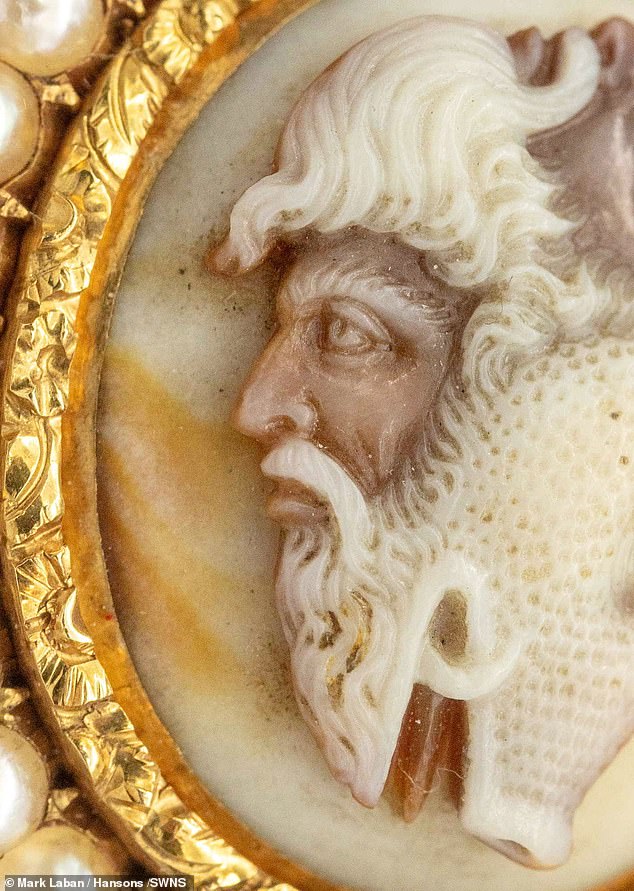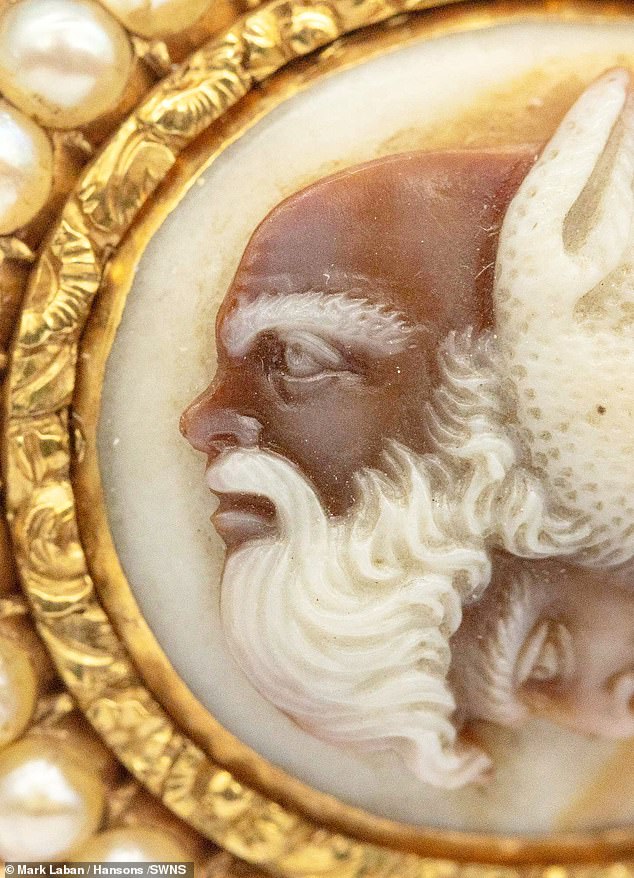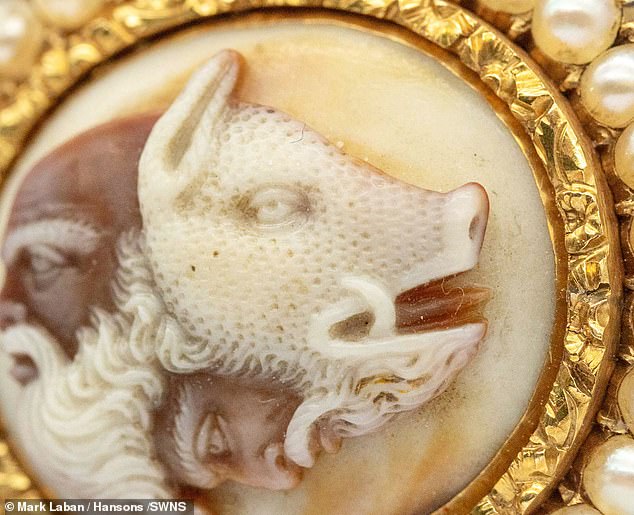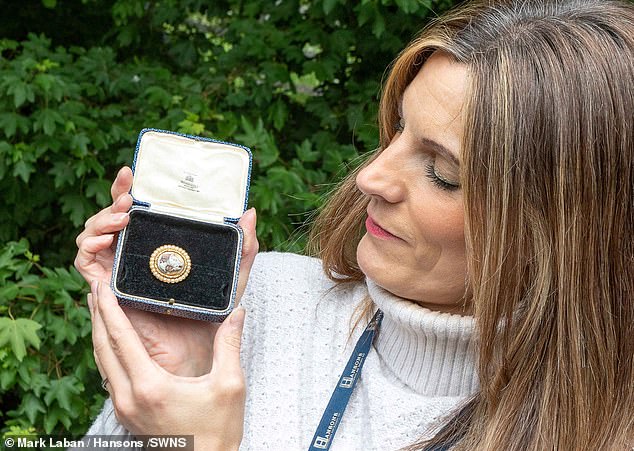Antiques Roadshow guest is stunned to find mother’s brooch which spent decades sitting in bedside drawer is 300-year-old treasure worth £7,000
A woman was left stunned after a brooch left in a bedside drawer for decades turned out to be a treasure worth thousands of pounds.
Helen Scaife, 51, decided to have her mother’s inherited jewelery valued on the BBC’s Antiques Roadshow after it had been collecting dust in her bedroom for years.
She was stunned when experts revealed that the brooch was hundreds of years old and was a highly valuable rare relic with ancient Roman origins.
The historic piece of jewelery – crafted more than 300 years ago during the Renaissance – is now expected to sell for as much as £7,000.
Helen plans to spend the money on her mother’s retirement. She says, “That’s a lot of money at a time when my mother doesn’t have much.”
The brooch has been in Helen Scaife’s bedside table for decades

Helen Smith, head of jewelery at Hansons Auctioneers, examines the brooch
The brooch, which depicts a gryllus, a strange creature with joined heads of humans and wild boars, will be up for grabs at Hansons Auctioneers in Etwall, Derbyshire, on June 27.
Helen said the rare piece had been in her bedside table for decades and had been passed down from mother to daughter for at least three generations.
‘It’s certainly been in the family since the 19th century. My grandmother was born in 1909 and it has certainly been in the family since then.
‘My mother inherited it more than thirty years ago. She’s worn it occasionally, but for the most part it’s tucked away in a bedside table.”
No one in Helen’s family knew how they acquired the brooch or had any idea of its value until its historic family tree was revealed on TV by jewelery expert Geoffrey Munn.
It delivered one of the series’ classic jaw-dropping moments and left Helen gasping.
Helen, a civil servant from Cardiff, said: ‘My friend bought tickets for the Antiques Roadshow and invited me to go with her.
“We went because we love the show, and she had a few little things to do.
‘I immediately thought of the brooch because we were always curious about what it was, having never seen anything like it.
“All the cameos we had seen or Googled in the past were invariably faces of women or Greek gods.
‘Nothing we ever came across looked like our brooch, so I hoped someone could tell us what it was and where it came from.
“I didn’t expect what we discovered, which I think is evident from the show.
‘When I came home, my mother didn’t believe me at first. She thought I was pulling her leg.
“I wanted to try to keep it a secret until the show aired, but ultimately I decided it wouldn’t be fair to her. And she has a way of getting information out of me.”
Helen has decided to part with the family heirloom ‘for a combination of reasons’.
She said: ‘Firstly, now that we know how much it could be worth, my mother is worried about insurance.
“And if what Geoffrey suggested turns out to be worth it, that’s a lot of money at a time when my mother doesn’t have much.
‘She just turned 78 and I want her to enjoy herself for the rest of her life.
‘If the sale of the brooch makes that possible, then it is worth a lot more to me than it is in a drawer.’
She added: ‘I love it and think it’s a beautiful object, but I wouldn’t wear it, and it seems like a terrible shame to keep it hidden.’

The brooch was identified as an intaglio gryllus cameo brooch dating to the late 16th or early 17th century

Carved into agate stone, the gryllus is a comical combination of animal and human forms seen in Greco-Roman glyptic art, especially in intaglio

Helen Smith, head of jewelery at Hansons Auctioneers, said: ‘These imaginative creations were popular subjects in ancient Rome and were often carved into gemstones.’
The brooch was identified as an intaglio gryllus cameo brooch dating to the late 16th or early 17th century.
Carved into agate stone, the gryllus is a comical combination of animal and human forms as seen in Greco-Roman glyptic art.
Commenting on the brooch, Helen Smith, head of jewelery at Hansons Auctioneers, said: ‘What a find. The brooch is a miniature work of art, extraordinary and beautiful. It’s so rare that I’ve never worked with an example like this before.
‘Collectors will be fascinated by the image of a gryllus, a mythical creature.’
The name Gryllus is derived from the cursive word ‘Grillo’ meaning ‘freak’ and the Latin word ‘Gryllus’ for caricature.
Mrs Smith continued: ‘These fanciful creations were popular subjects in ancient Rome and were often carved into gemstones.
‘Although these grotesque images were amusing, they had a more serious connotation.
‘It was believed that they protected anyone who wore them from demonic spirits.
‘It is a wonderfully complex object. The carving depicts three joined heads, two classical figures and the head of a wild boar.
‘The cream-colored background emphasizes the dark and light complexity of the carving. The attention to detail is incredible.
‘The agate itself measures only 20mm x 17mm and is set in a later gold and pearl set frame from around 1840.
‘Agate stone symbolizes strength, protection and courage. It is often associated with emotional stability, inner peace and self-confidence.
‘So both the choice of decoration and the material used could have been linked.’

Helen Smith (pictured), head of jewelery at Hansons Auctioneers, said: ‘What a find. The brooch is a miniature work of art, extraordinary and beautiful. It’s so rare, I’ve never dealt with such an example.”
Mrs Smith added: ‘A mythical beast that chases away demons, made from a material believed to calm the wearer.
‘For any jewelry connoisseur, this brooch is exceptional. It also reminds you to reach into those dusty corners, empty the drawers and look under the bed.
‘The best auction finds are often made here.’
